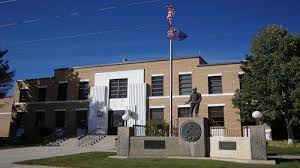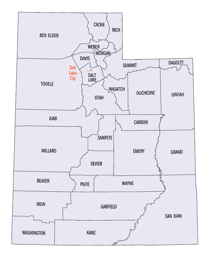Utah Counties
There are twenty-nine counties in the State of Utah. There were originally seven counties established under the provisional State of Deseret in 1849: Davis, Iron, Sanpete, Salt Lake, Tooele, Utah, and Weber. The Territory of Utah was created in 1851 with the first territorial legislature meeting from 1851-1852. The first legislature re-created the original counties from the State of Deseret under territorial law as well as establishing three additional counties: Juab, Millard, and Washington. All other counties were established between 1854 and 1894 by the Utah Territorial Legislature under territorial law except for the last two counties formed, Daggett and Duchesne.Emery County, Utah
Emery County Education, Geography, and History

Emery County is a county located in the state of Utah. Based on the 2010 census, the population was 10,976. Its county seat is Castle Dale, and the largest city is Huntington. The county was named for George W. Emery, governor of the Utah Territory in 1875.
Etymology - Origin of Emery County Name
The county was named for George W. Emery, governor of the Utah Territory in 1875.
Demographics:
County QuickFacts: CensusBureau Quick Facts
Emery County History
Emery County in southeastern Utah is bordered on the north by Carbon County (which was created from Emery in 1894), on the west by the Wasatch Plateau and the original settlements in Sanpete and Sevier counties from which most Emery County settlers came, on the south by the remote artificial boundary with Wayne County, and on the east by the Green River--the natural boundary with Grand County (which was created from Emery County in 1890). Emery County includes three geographical areas: the mountains of the Wasatch Plateau; Castle Valley, where the major settlements are located; and the desert of the San Rafael Swell, the San Rafael Reef, Cedar Mountain, and the remote stretches of land west of the Green River. The San Rafael River, the lifeblood of the county, originates in the Wasatch Plateau where the headwaters are stored in several reservoirs for agricultural and industrial use. It flows into Castle Valley in three branches - Huntington Creek, Cottonwood Creek, and Ferron Creek - which unite to form the San Rafael River after they pass the communities and adjacent farm land. It then twists its way through the rock and desert to its junction with the Green River.Occupation of the San Rafael region dates back thousands of years to include people of the Archaic Period who were followed by those of the Fremont Culture who inhabited present-day Emery County from about A.D. 500 to 1300 Evidence of these people can still be found in numerous pictograph and petroglyph panels, such as those in Temple Mountain Wash, Muddy Creek, Ferron Box, Black Dragon Canyon, and Buckhorn Wash, all sites listed in the National Register of Historic Places. In historic times Ute Indians occupied sites in Castle Valley, and travelers along the Old Spanish Trail also passed through the present county.
In 1875 livestock growers from Sanpete County, recognizing the settlement potential of the region, brought cattle and sheep into Castle Valley to graze. With a shortage of sufficient land and water in Sanpete County and a strong desire by Mormon church leaders to acquire unoccupied land in the region before non-Mormons did, young families began moving into Castle Valley in the fall of 1877 to take up homesteads in what would become the settlements of Huntington, Ferron, Castle Dale, and Orangeville.
Although livestock and farming remained the mainstay of the county's economy throughout most of its history, two related events affected the region's economic stability: the completion of the Denver and Rio Grande Western Railroad through Emery in 1883 and the development of the coal mines at Scofield, Castle Gate, and Sunnyside in Carbon County by 1895. The railroad provided the transportation for produce and livestock, while the mines provided a nearby market for animals and vegetables and an opportunity for some Emery residents to work in the mines during winter and farm during summer. The D&RGW also led to the establishment of the town of Green River, although the site had been an important part of the Old Spanish Trail and a mail station had been established there before completion of the railroad. During the 1970s Emery County's population grew significantly because of the construction by Utah Power and Light Company of large power plants in Castle Dale and Huntington and the opening of large coal mines to fuel the power plants.
*Source: Beehive History 14: Utah Counties. 1988. Utah State Historical Society, 300 Rio Grande, Salt Lake City, UT 84101-1182.
Geography: Land and Water
As reported by the Census Bureau, the county has a total area of 4,462 square miles (11,555 km2), of
which, 4,452 square miles (11,530 km2) of it is land and 10 square miles (25 km2) of it (0.22%) is water. The
Green River forms the eastern boundary. The Wasatch Plateau, a mountainous area, sits along the western
boundary. The main population of the county lives along the base of these mountains. The San Rafael Swell
occupies most of the area to the east.
Neighboring Counties
Bordering counties are as follows:
- Carbon County, Utah (north)
- Grand County, Utah (east)
- Wayne County, Utah (south)
- Sevier County, Utah (southwest)
- Sanpete County, Utah (northwest)
Education







